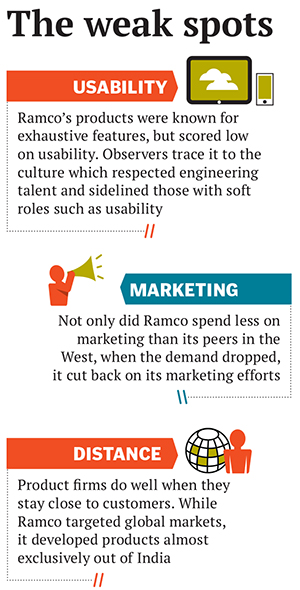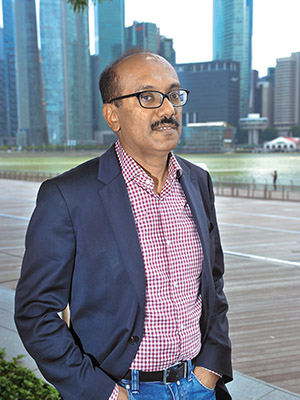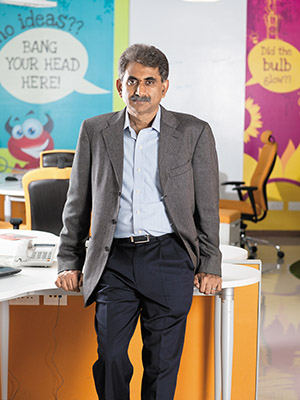
Ramco's Turnaround: Can a new CEO do it?
Virender Aggarwal is effecting a painful change at Ramco. Will he succeed?
Among Indian tech firms, Ramco Systems has a reputation that its peers only aspire for. Engineers tend to say nice things about its products. Even its rivals speak of how Bill Gates, when he was still the CEO of Microsoft and Microsoft still dominated the information technology scene, launched one of its products. For long, it had the handholding of CK Prahalad, a much-sought-after management guru, because he believed that India could build a global IT product, and Ramco just might be that company.
All well, except for one small detail: Ramco never really made any money. By end of March 2013, it had accumulated losses of Rs 62.9 crore, which may look small, but sits uncomfortably in a company that started product development 20 years ago. The joke among journalists who cover Ramco is that its turnaround story is a never-ending one.
To be fair, Ramco adopted new technologies—solution accelerators, cloud, etc—ahead of its peers. “The most important advice Prahalad gave us was about the clarity and persistence of vision. He told us you can’t compete with the big guys—the market is dominated by five large players—by being marginally better than them. You have to be dramatically different, and give much higher value than the rest,” says PR Venketrama Raja, vice chairman and managing director of Ramco Systems.
Raja believes the payoff time is closer than ever before. “After a long time, Ramco might have got it right,” says Sunil Padmanabh, research director at Gartner, who has been tracking the company and the IT products space for years.
Enter Aggarwal
One of the reasons for the new perspective is a raft of changes at Ramco in the last several months. On top of these changes sits its new CEO Virender Aggarwal, who moved to Ramco in 2012 from HCL Technologies. In many ways, he is the opposite of his former boss Vineet Nayar, who was by many accounts a marketing type—gregarious, hard talking and boldly confident. Aggarwal, on the other hand, is a techie type: He talks in short clear sentences. But he had also displayed enormous business savvy at HCL, growing its emerging markets portfolio to half a billion dollars.

Meanwhile, Aggarwal’s efforts are being closely watched: His success (or failure) will test several hypotheses that industry watchers have about Indian companies trying to launch a successful software product. Indian companies have not had much success in that. “The issue standing between Indian companies and success in the product space is not one of capability—which they have in droves—but one of proximity. You need to be physically present in the market that will use your product to truly understand the contextual and functional nuances that need to go into your software,” says Sid Pai, partner and president of consulting firm ISG’s Asia Pacific region.
There are some very good examples where Indian companies have built excellent products such as Bancs, Finacle, the On-Mobile product suite, and Tally, but each one of them was originally designed for a market with which their product designers had great familiarity, Pai says.
The Problem Beyond the Product
“Ramco’s problem is not that they don’t have a brilliant product,” a senior executive from a technology company says. “They are probably technically brilliant. Ramco’s problems lie elsewhere.” The marketing head of another technology company says: “The key is not in just building a product. If that’s the case, we will all be billionaires.”
Aggarwal’s own diagnosis of Ramco’s problems is simple: Its products scored low on usability, and it spends too little on marketing. He has been busy setting these things right ever since his arrival.
The reason why its products scored low on usability had to do with Ramco’s culture. It had always been an organisation dominated by engineers—not least because its promoter Venketrama Raja, a chemical engineer from Madras University, had a passion for products and engineering, and has been closely involved in its operations. (Raja, along with Ramco Industries and Madras Cements, own 68 percent in the company.) And engineers aren’t always the best people to think of products with lay users in mind. So, one of the first things Aggarwal did was to stress on usability. He hired over 20 usability experts (Ramco employs around 1,200 people) and made it known that nothing would go to customers unless the usability team gives the go-ahead.
To score higher on usability means the product has to run on mobile devices which, in effect, means everything has to be on cloud, an area that Ramco was already focusing on. Since Aggarwal’s arrival, all the products are built for the mobile first—and they all have elements drawn from the services that define this era: Facebook, Foursquare, Twitter, and, of course, Google. So, an executive checks into an office using his mobile, enters a data centre or conference room using a QR code, uses the maps on his mobile to check on his customers in that location, much the same way one might check out restaurants and so on. (QR code, or quick response code, is a machine readable code, similar to barcodes, but can store more information.)
Importantly, there is more stress on marketing than ever before. Insiders say that when its products failed to take off in the market, instead of turning more aggressive, the executives turned more inward looking, and instead of stepping up the marketing efforts, started investing less on marketing. That has changed since Aggarwal arrived. The team is practically new. (The story goes that sometime after he took charge, he sent a mail to his marketing team asking for their views on a certain issue. Some responded, some didn’t. He asked the HR department to fire those who didn’t respond, saying, ‘if they don’t respond to their CEO, would they respond to their clients?’)

The Crucial Piece of Change Management
Insiders say that these changes haven’t happened without a lot of heartburn. One employee complained that Aggarwal has always been in IT services and doesn’t understand that the products business is different—and might end up destroying the core strength of Ramco, its engineering, by changing too many things too fast.
Aggarwal is aware of the shockwaves that he has sent inside the company, but he believes he has done the right thing. Some time back, Ramco had invited a professor from Harvard, Boris Groysberg, who specialises in organisational behaviour, to help it through the change. The big learning from Groysberg, Aggarwal says, was that change, first of all, should be fast. Do it at one go, and be done with it (instead of letting people speculate what will happen next).
Groysberg also advised the team not to get too emotional about letting people go. “There was a fair degree of shock at the speed at which change took place. But now, the degree of acceptance is creeping in. There has been some pain. But, when we succeed in the market that pain will go away,” Aggarwal says.
(This story appears in the 04 October, 2013 issue of Forbes India. To visit our Archives, click here.)
-
 Raj
RajThink the verdict is out there! Ramco has been on path to profitability and announced its break-even with a small profit last quarter. With large clients like Malaysia Airlines
on May 29, 2014 -
 Arun
ArunI strongly feel that RAMCO has got an excellent product for the HCM space. Strong Leadership, Vison and Focus on marketing was lacking and Virendra Agarwal is the right person for taking the journey further and faster
on Nov 15, 2013 -
 Bringaraj M
Bringaraj MIt has been over a year and half that VA has been in charge, fiscal results for six quarters have flown under the bridge, the erstwhile best of the company have been packed home and replaced by \"six senior executives to spearhead its global growth plans\". If one were to now make a reasonable guess at the answer to the question asked in the header, what is the most likely possibility. It is not just that neither VA, or his champions have never fended for an indigenous product and known to have won. Frankly, he is as bereft of ideas now as he was when he walked in. It is one thing to talk about \'being a Google\' or \'humbling a Workday\' (the famously \"inspirational\" bluster which VA and his team put up) and another to dig in with the facts and realities to have a semblance of a strategy.
on Nov 3, 2013 -
 Murali Prasad
Murali PrasadArticle is OK but it is Sad that ramco has lost some outstanding people in the last few years. I was a Ramco customer for a long time untili I made a switch to another company providing true HR on the cloud. Pity is that Ramco had some great people who have battled very adverse conditions against stiff competitions and they have left. the new team is far from impressive.
on Oct 24, 2013 -
 Sarat
SaratWhen the processes are good enough customers will comeback otherwise products will come back!!! Ramco's HR and recruitment system is pathetic, giving basic computer aptitude questions of primary school level to freshers' as well as middle level executives...the rooms are not ventilated well with stinking sweat smell and of Course you are badly greeted by the security who wont allow you to park your car inside the office space, so you need to park at main road for the traffic police to book it and tolled away..the people who come to take interview look like labors from field with no professional sense..the tamil accented English and culture everywhere.. so to conclude Ramco is not the first choice for any IT professional, also they offer salaries which are a pity!
on Oct 1, 2013 -
 Telangana Raja
Telangana RajaThere is business rule in first 3 years business or company turnaround is must if not mean they are surviving or going to shut the doors , in lucky cases very very few survive , best example see the world wide new establishments
on Oct 1, 2013 -
 P B Sreekumar
P B SreekumarGood to know some one is focusing on the marketing aspect of the company and the product. As an alumni of Ramco Systems and probably one of those who sold their first ERP Marshal, I wish them to do well like their peer IT companies founded during the same time. I still remember the days when Mr. Raja had nurtured this company and the product to counter MNC ERP\'s when ERP was a concept and not a commodity like today.
on Sep 28, 2013 -
 Muthu
MuthuAny product should speak for itself and marketing could only be icing on the cake. Use any of the Ramco products and you would get to know the sorry state in which they are. It would be good if the CEO could muster all his strengths to improve the products first and then do vehement marketing. Until then marketing the products in the uncharted lands would only be a deceiving exercise and could easily backfire.
on Sep 27, 2013 -
 Nakul N
Nakul NIf memory serves right, Ramco has clocked success stories with an extremely complex software like ERP at some marquee customers in US, Europe, ASEAN and MEA (even leaving aside India) since late 90\'s. No mean feat this, esp. doing things, as they say, \"away from the markets\". Amazing too is a company this size, sustaining in so many markets for nearly two decades, still capable of notching up successful case studies. One hopes the end diagnosis is not too simplistic or proxy for a goal quite Herculean.
on Sep 26, 2013 -
 Indranil Roy Chowdhury
Indranil Roy ChowdhuryI agree that Ramco should be close to the market, else it will be difficult to deliver a great product. For instance we tried to test Ramco HR suite for our company which is in the staffing space. But at the end of day we all felt that it was not really adaptable to the special needs of the staffing industry. Yet I was pleasantly surprised to see Ramco promoting itself in staffing forums
on Sep 26, 2013 -
 Rajesh Prasad
Rajesh PrasadThe jury is still out on what VA\'s actions have brought to Ramco, apart from his coterie that VA always takes whenever he changes jobs. The Product promise mindset is sadly a victim in this so called transformational exercise. Blaming the people who have created Ramco from scratch is the easiest part and letting go of people is the next easiest part. The challenge is to be inspirational, set new vision, motivate employees and deliver results.
on Sep 26, 2013
















